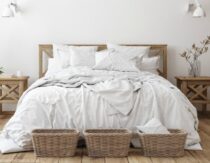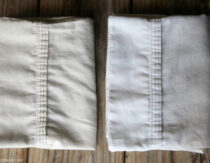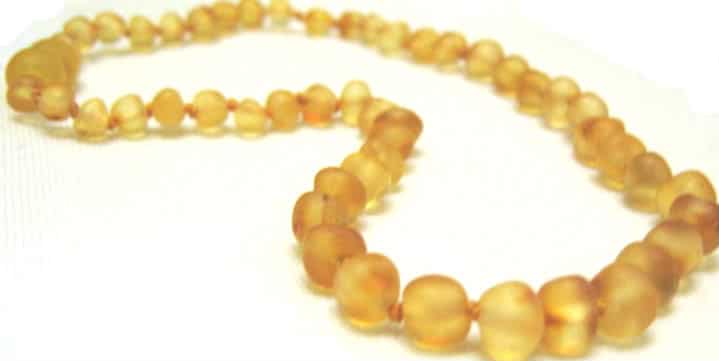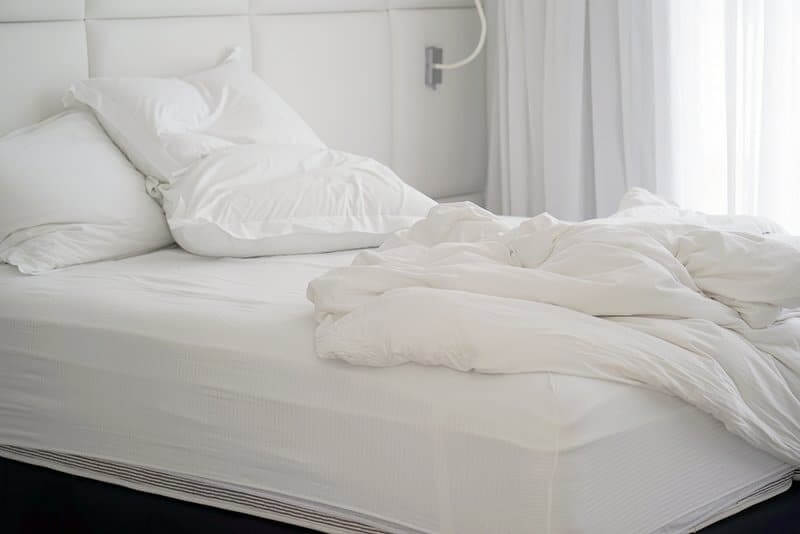
There are so many things to consider when shopping for a non-toxic mattress, so let’s start with some mattress shopping basics and work our way from there, okay?
How To Get Around Toxic Fire Retardants
All mattresses are required by law to contain fire-retardant materials unless you receive a prescription from a doctor. Unfortunately, the cheapest and most common way to make mattresses fire-retardant is to douse them in toxic chemicals. Fortunately, there are a few alternatives:
“Some organic mattresses pass fire standards by using wool since wool is a fiber with natural fire retardant properties. There are companies that use only pure wool for this purpose. But be aware that some companies use wool with chemical treatments added to boost the wool’s fire resistance” (source).
Unfortunately, some people are sensitive to wool, so this is not always a viable solution. Other workarounds include using hydrated silica or boric acid.
Misleading “Natural” & “Organic” Product Labels
According to this article, “Just because a mattress is called organic does not mean that it’s non-toxic. It really depends on all the materials used. A mattress can be called organic if it contains any organic component such as an organic cotton filling or even just an organic cotton surface fabric. Some organic mattresses have organic cotton filling with a vinyl covering. These may be called organic mattresses, but because of the vinyl covering (and most likely chemical fire retardants), these mattresses are obviously not all that healthy. It’s important to check into all materials used, and it can be difficult to get full disclosure from the retailers or the manufacturer.” Here are a few other factors to consider:
#1: Wool covers are water-resistant but not 100% waterproof…
Which means that if there is cotton layer underneath the wool it could get wet and mildew. To get around this, either go with a naturally hypo-allergenic, anti-microbial and dust mite resistant natural latex mattress or consider an organic mattress with a waterproof layer made of low density, food-grade polyethylene.
“Environmental scientists agree that low density, food-grade polyethylene is the safest plastic available for waterproofing a crib mattress. It has a simple molecular structure and does not contain phthalates or other unsafe additives. Unlike the production of vinyl, dioxins and other toxic chemicals are not released into the environment during production of low density polyethylene . . . Strict independent testing confirms there are no phthalates or any toxic chemicals in this polyethylene.”(source)
#2: Natural rubber (latex) **may** contain proteins that are allergenic…
To some people and could therefore be problematic. This company says that “As of yet, there have NOT been any reported cases of allergies to Pure Natural Latex (or Pure Natural Rubber) and the general incidence of latex allergy is low, less than 1% of the U.S. population. People that are allergic to latex are normally allergic to the type of latex used in making latex gloves (workers who wear latex gloves most of the day have a risk of less than 10%) which is closed cell structure latex.”
They also offer to send you a free test kit if you are considering a purchase. Also, it’s important to know “there is no such thing as 100% pure natural rubber latex. In order to make the natural rubber into a foam block, there has to be some chemical processing. Some natural latex does come close to pure, but there are many mattresses out there that are called natural latex that really are a blend of natural rubber and toxic chemicals. So if you want a latex mattress for your baby, you need to dig deep to find one that is as pure as possible.” (source)
Got it? NO?
That’s okay! Let’s start over.
First, check out company ratings in this buying guide (thank you Renee K for sharing this resource!). Though it’s specifically geared toward crib mattresses many of the companies reviewed also have adult-sized mattresses available. Once you’ve decided on a couple you’re interested in, check them against the tips above to see if any red flags come up.
A few comments about the buying guide’s recommendations: Though boric acid is considered by some to have a low toxicity rating, I’m just not comfortable with using roach killer as a waterproofing agent. Also, antimony is listed as a “chemical of concern’ but arsenic and phosphorous are not. I would double check with manufacturers on whether they contain these two compounds before making a final decision on a purchase. Finally, I would avoid any mattresses that have un-waterproofed organic cotton rather than wool/latex as the surface material. It’s just too easy for it to accidentally get wet and mildew. Removable cotton pads/wool pads that can be washed are fine.
Speaking of removable moisture-absorbing covers, this is the most ridiculously cheap and easy option available – just cover with a cotton sheet and you’re done! If you’re not familiar with wool, it has historically been used as a diaper cover because it is very antimicrobial. Unlike sheepskins, which should be washed only rarely, I’d go ahead and wash these often even though they won’t last as long to prevent the development of S. Brevicaulis. Wool requires special care when it come to washing, but if you follow these instructions you should be fine (make sure to put them in the dryer or hot sun to prevent mildew).
Note: Firm mattresses are typically recommended for babies, especially if they are being placed on their tummy to sleep because a soft mattress could interfere with breathing. Wool puddle pads and other pads are considered fine by most, but I’d personally make sure it’s not too “cushy” in there!
Question #2: I Can’t Invest In A New Mattress Right Now. Is There A More Affordable Option Available?
Yes, you can wrap your current mattress (or your baby’s crib mattress) in a low density, food-grade polyethylene cover (commonly called the Babesafe cover). It’s fairly inexpensive, and as I mentioned earlier “food-grade polyethylene is the safest plastic available for waterproofing a crib mattress [or other mattress]. It has a simple molecular structure and does not contain phthalates or other unsafe additives. Unlike the production of vinyl, dioxins and other toxic chemicals are not released into the environment during production of low density polyethylene . . . Strict independent testing confirms there are no phthalates or any toxic chemicals in this polyethylene.” (source). It’s also really easy to use:
Downsides: According to reports it’s pretty noisy, so if you’re the type to sneak out of bed after your littles fall asleep (like my husband and I do every night) be warned! Also, keep in mind that polyethylene is not breathable – you’ll probably want to add a washable cotton mattress pad over the cover if it’s going on an adult bed. A cotton sheet is all that is recommended for crib bedding so that the sleeping surface is firm rather than squishy).
The Soft Landing has a helpful guide to selecting a good mattress cover here.
Question #3: If I can’t afford a new non-toxic mattress should I replace my old one with a conventional mattress?
I probably wouldn’t. Though it’s less likely to contain fungus and bacteria, the “new” smell it comes with means it’s off-gassing tons of chemicals into the air. I’d just wrap my old mattress and start saving for a better one down the road.
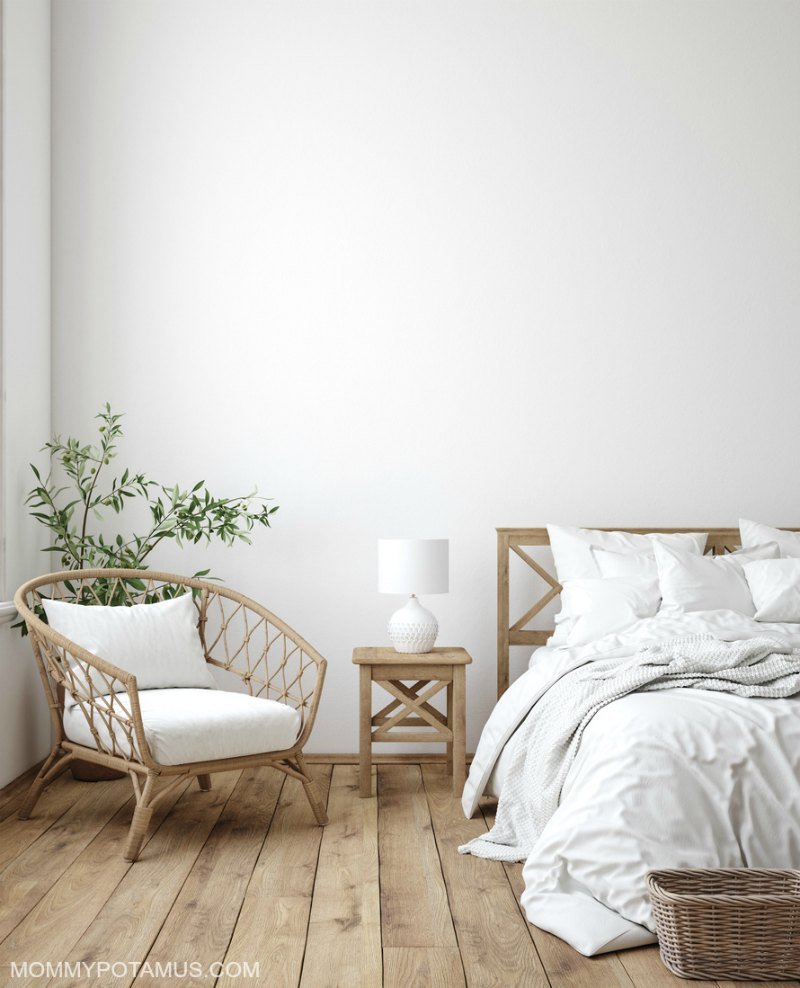
Want a FREE ebook of non-toxic cleaning recipes that WORK?
I’ve created a free ebook for you as a gift for signing up for my newsletter. 7 Non-Toxic Cleaning Recipes That Really Work covers seven recipes that you can make in just a few minutes each for squeaky clean windows, sparkling dinnerware, lemon-fresh countertops, and more. Subscribe to my newsletter below and you’ll be redirected to a download page for immediate access to this PDF ebook.

